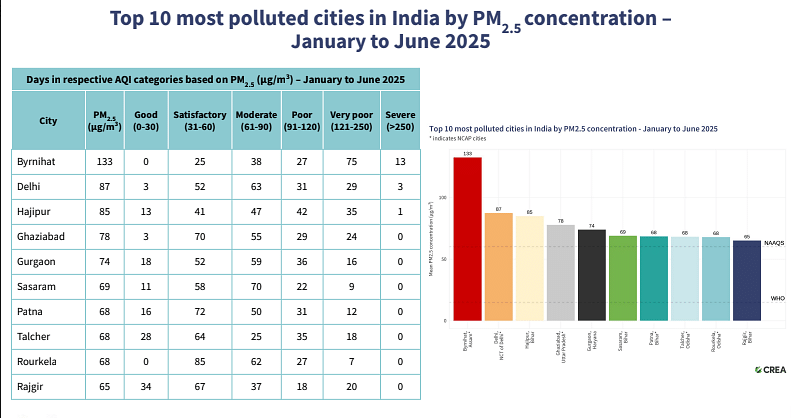Delhi Remains Second Most Polluted City in India Despite Vehicle Restrictions: CREA
Over 88% of Indian cities exceed WHO air quality standards in first half of 2025.
Delhi ranked as India's second most polluted city with PM2.5 levels averaging 87 μg/m³ during the first half of 2025, according to a report released Friday by the Centre for Research on Energy and Clean Air (CREA), which analyzed air quality data from 293 cities to reveal widespread non-compliance with national and international pollution standards.
The analysis shows that 122 out of 239 cities with adequate monitoring data exceeded India's annual National Ambient Air Quality Standards of 40 μg/m³, while all 239 cities surpassed the World Health Organization's stricter annual standard of 5 μg/m³.
Byrnihat, located on the Assam-Meghalaya border, emerged as the country's most polluted city with an average PM2.5 concentration of 133 μg/m³. The city experienced the majority of its days in the 'Very Poor' air quality category and did not record a single 'Good' air quality day.
Delhi overshot the WHO annual PM2.5 limit as early as January 10, 2025, and crossed the National Ambient Air Quality Standard by June 5, 2025. This ensures that Delhi will remain in violation of both standards for the remainder of the year, regardless of subsequent pollution trends.
By June 2025, 259 out of 293 cities had already overshot the WHO's annual PM2.5 standard, indicating widespread non-compliance across the country. In contrast, only three cities had overshot the Indian NAAQS by the same point.
The report highlights that vehicle restrictions alone are insufficient to address Delhi's air pollution crisis. Source apportionment studies from the Portal for Regulation of Air-pollution in Non-Attainment cities and IIT Delhi show that while transport contributes 17% to 28% of PM2.5 levels, other significant sources include dust (17% to 38%), industrial activities and power plants (22% to 30%), residential combustion (8% to 10%), and agricultural burning (4% to 7%).
Enforcement gaps remain a major concern. Despite Supreme Court directives, most thermal power plants near Delhi still lack Flue Gas Desulfurization systems. As of mid-2025, only two of eleven plants within 300 km have operational FGDs.
"Addressing the air quality crisis in any Indian city requires a multi-sectoral approach. Fragmented or seasonal measures are not enough. Urgent steps are needed to update national standards, expand NCAP coverage to gaseous pollutants, and enforce mitigation measures for all polluting sources to safeguard public health throughout the year," said Manoj Kumar, Analyst at CREA.

Other cities in the top 10 most polluted list include Hajipur, Ghaziabad, Gurgaon, Sasaram, Patna, Talcher, Rourkela, and Rajgir. Bihar accounts for four of these cities, Odisha for two, with the rest spread across Delhi, Assam, Haryana, and Uttar Pradesh.
The current NAAQS, established in 2009, have not been updated since and are misaligned with international recommendations. The report calls for urgent revision of national standards to better safeguard public health.
The analysis draws on data from Continuous Ambient Air Quality Monitoring Stations in 293 cities, with PM2.5 data available for over 80% of days in 239 cities during the January-June 2025 period.
RELATED ARTICLES
Range Rover Introduces Compact ‘R’ Motif, Lettermark Stays
The new symbol will not replace the Range Rover lettermark but will instead be used in smaller areas and on merchandise....
Ather to Unveil New EL Electric Scooter Platform on August 30
Ather’s Community Day this year will also see the reveal of the company's new fast chargers.
Continental, IIT Delhi, and RLF Expand OnBoard Accessibility Solution in Bengaluru
Continental partners with BMTC to expand the OnBoard system for visually impaired commuters, aiming for deployment in 50...





 By Shruti Shiraguppi
By Shruti Shiraguppi
 11 Jul 2025
11 Jul 2025
 1261 Views
1261 Views





 Autocar India
Autocar India



 Sarthak Mahajan
Sarthak Mahajan

